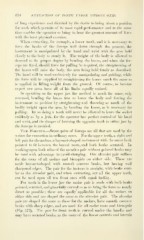Page 636 - My FlipBook
P. 636
634 EXTRACTION OF TEETH UNDER NITROUS OXID.
of l(MiL!; ('X)>(>ri(Mi('(» and dictated by the desire to hriiii^ uhout a ])()sition
for work wiiieli permits of its most rapid performance and at tiie same
time enables the ()i)erator to bring to bear tlie greatest amount of force
with the least physical exertion.
When extracting, for exam])le, a lower tooth, and it is necessary to
force the beaks of the forceps well down through the process, the
instrument is nianij)ulated by the hand and wrist with the arm held
closely to the body to steady it. The weight of the body is allowed to
descend to the pi'oper degree by bending the knees, and when the for-
ceps are fixed, should force for pulling be required, the straightening of
the knees will raise the body, the arm being held firmly as described.
The hand will be used exclusively for manipulating and guiding, w^hile
the force will be supplied by straightening the knees much the same as
is applied in lifting weight from the ground. Of course, to become
expert one must have all of his limbs equally trained.
In operating on the upper jaw the method is much the same, only
reversed, bending the knees first to lower the body and forcing the
instrument to position by straightening and throwing as much of the
bodily weight upon the arm, by bending the knees, as is necessary for
pulling. By so doing a tooth will never be allowed to leave the socket
suddenly as by a jerk, for the operator has perfect control of his hand
and wrist, and the danger of bruising the opposite teeth in either jaw^ by
the forceps is avoided.
The Forceps.—Seven pairs of forceps are all that are used by the
writer for extraction in ordinary cases. For the upjier teeth, a right and
left pair for the molars, a bayonet-shaped instrument with the outer beak
pointed to fit between the buccal roots, and both beaks serrated. In
working upon both sides of the mouth a pair without pointed beaks may
be used with advantage to avoid changing. One alveolar pair suffices
for the roots of all molars and bicuspids on either side. These are
made bayonet-shaped with smooth concave beaks, but having well
sharpened edges. The pair for the incisors is straight, with beaks simi-
lar to the alveolar pair, and when extracting, say all the upper teeth,
can be used upon all ten front ones with equal facility.
For teeth in the lower jaw the molar pair is made with both beaks
pointed, serrated, and gracefully curved so as to bring the force as nearly
direct as possible; these are equally applicable for all the molars on
either side and are shaped the same as the alveolar pair. The alveolar
pair are shaped the same as those for the molars, have smooth concave
beaks with sharp edges, and are used fir all molar roots and bicuspids
(Fig. 572). Tlie pair for front teeth is curved under the handle and
may have serrated beaks, as the roots of the lower centrals and laterals


